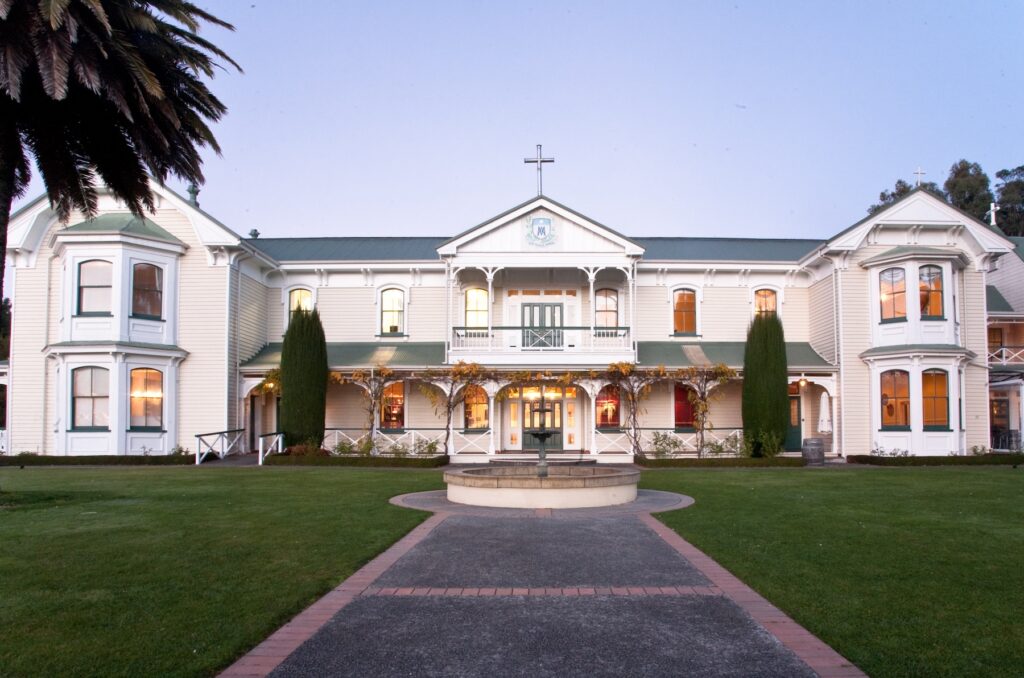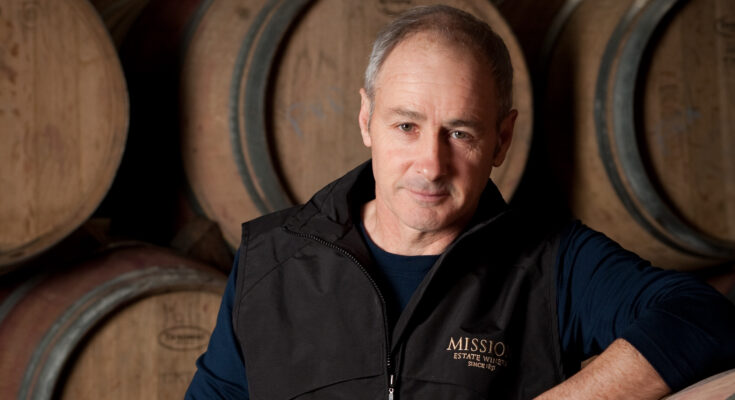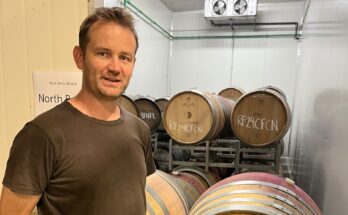Wine Folio: Mission is one of my favourite places. I remember coming here early on when we’d moved here from the UK in 2003, and just thinking what a fabulous place. It’s a fantastic winery experience.
Paul Mooney: We’ve got the history and tradition. My predecessor, Brother John was trained in Bordeaux, so came from there in the ‘60s, and developed the first Methode – ‘Fontanelle’. There’s a bottle in the doorway at the top. The next guy to do it was Mate Selak. When he came back he brought a handbook – 4 tomes, one on viticulture, one on processing and so on.
WF: Do you have to speak French as part of the job?
PM: No, but I used to use those books with a dictionary, you know. They’ve got a lot of detail and expertise in the technique.
WF: Is it quite different from how you would have learnt to make wine if you’d gone to school in Roseworthy, for example?
PM: Definitely. It was different back then, a different approach. A lot of kiwis do their vintages in France, in Bordeaux these days. See the French approach to things.
WF: Do you mean a French approach to winemaking, or a view of life, and how wine fits into that?
PM: Perhaps both. We have a heritage, but most of our wines are what you would call ‘supermarket’ wines. We don’t have a huge marketing budget, or are owned by billionaires. We make a lot of different varieties – like Gewurztraminer and Riesling, and from $150 down to our Estate range at around $13-14. We acquired the Ngatarawa brands about three years ago, so we got a bit more scale. That gives more sustainability as a wine producer in Hawke’s Bay and certain advantages in costs and things like that. Also distribution – that can be hard work.
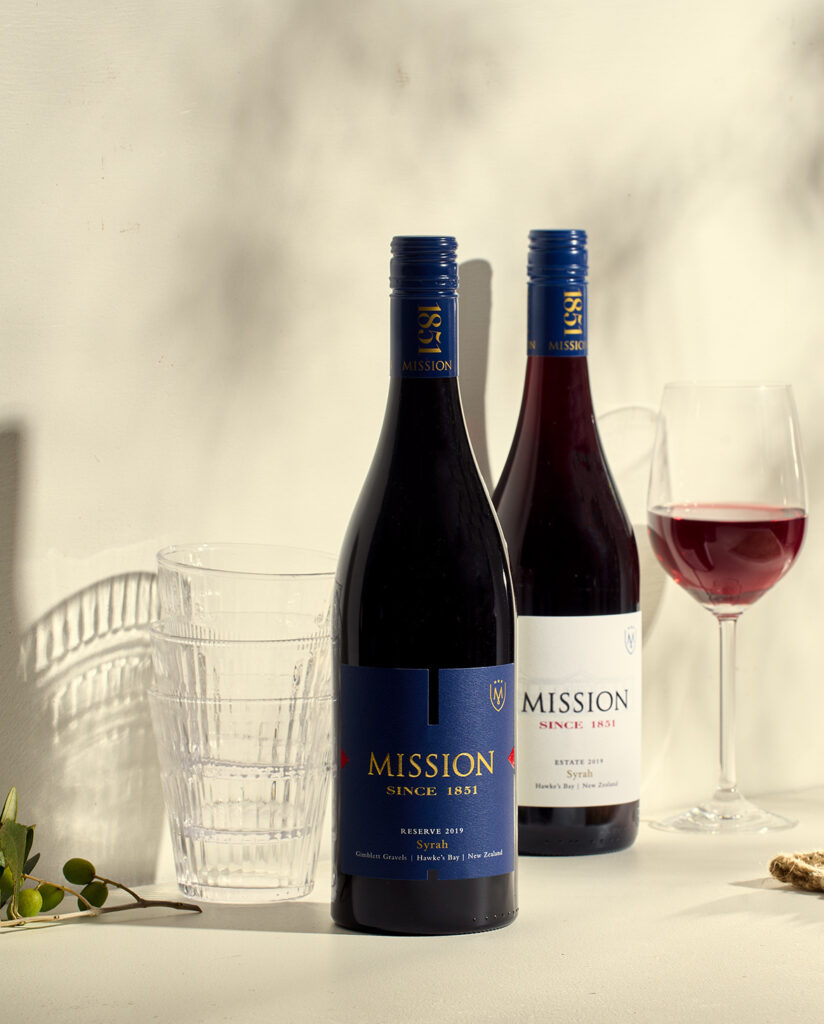
WF: It’s one thing making it, but getting it out there with marketing, sales and distribution…
PM: We now have an opportunity to fully utilise this production facility – given us scale and efficiencies. We put in a new bottling line so we put all our production through there. As an integrated wine company that does everything from growing, making the wine, bottling, sales, marketing, distribution – all from the one site, we are fairly unique company in Hawke’s Bay. We’re also very flexible, so we do a lot of third party work – some bulk processing for people who’ve got customers in the UK and some bottling.
And we do batches of fine wines. Our icon brand is Huchet, named after the first professionally-trained winemaker in New Zealand – that’s Cyprian Huchet. So as well as doing all that other stuff, we are working at the fine wine end. And we really wish to develop that. We’ve got very high quality vineyards now, including Gimblett Gravels. But on the other hand, our biggest vineyard holding is in Marlborough. So we’ve got a 73 hectare vineyard in Marlborough, which gives us the scope to develop export markets.
WF: What’s different about the fine wine end of it?
PM: It’s very targeted, so we started back in 2007 and did a NDDI map of our best vineyard, that grows Syrah and Merlot. Mapped it and looked at the variability of the vineyard, and target the best parts for our top wines. Then apply special techniques – more thinning or shoot positioning for example. So the first Huchet wine that we made was from about a quarter of a hectare. Hand harvested and fermented individually, kept in barrel specifically for that wine. We aspire to make something that’s really a reflection of the site. That ties back to the French idea of ‘terroir’, so it’s not about the winemaking so much as the site. The same goes for Cable Station, that’s a single vineyard in the Awatere Valley, near Lake Grasmere – it has quite unique flavours, a definite herbal aspect.
In Hawke’s Bay you find that wines from the Bridge Pa Triangle for example, have a different texture profile and aroma to that of the Gimblett Gravels. Parts of the Triangle – over near Sileni that are as warm as the Gravels, but bits over by Roys Hill that are cooler. The Gimblett Gravels does quite a bit of promotion – so every year they choose a dozen wines from the Gimblett Gravels. This year, our top Cabernet blend, named ‘Antoine’ is in the 2018 ABS selection.
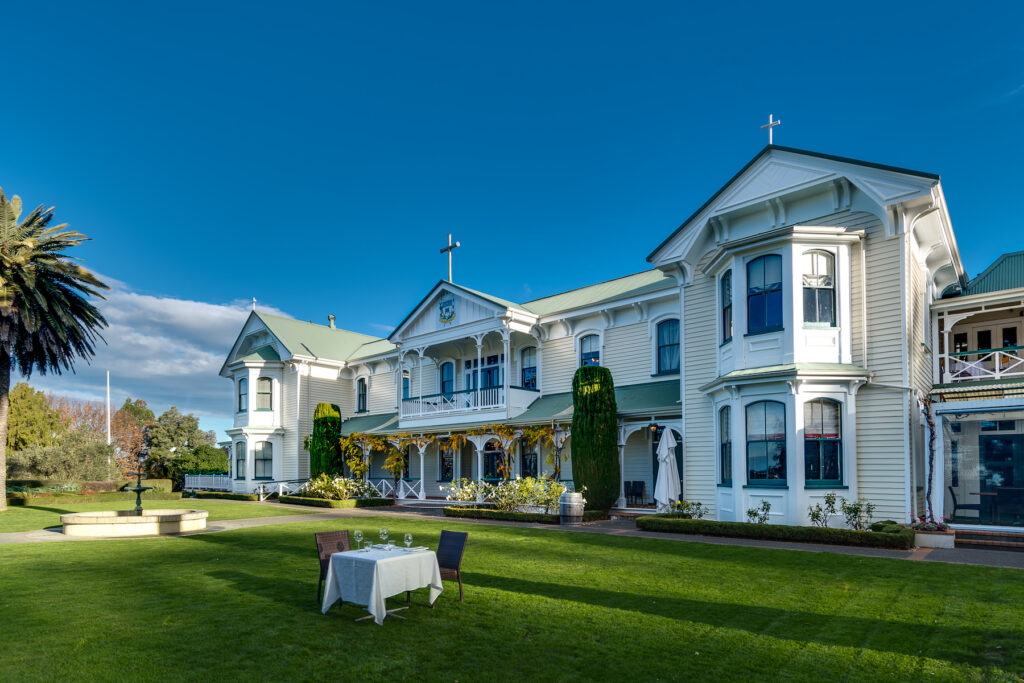
Aspiring to make those better, barrel-aged wines is what being a winemaker is about, for me. We’ve got about 700 barrels in our barrel hall – probably less than 10% of our production. I think if you are in Hawke’s Bay and just making barrel-aged wines, going for the top end, it’s pretty hard going. You’re up against Bordeaux and California, and who’s likely to have heard of Hawke’s Bay if you’re in New York or somewhere like that? It’s pretty hard because for one thing we just haven’t got the mass, the size, the production. As a wine company we’ve got broad distribution in New Zealand, and a good range – we have the ‘Reserve’ range that sells up to $30 and then the ‘Jewelstone’ range up around $50. Which some say, considering the quality, they’re too cheap. We’re having a crack at the fine wine end.
WF: Are things like ‘vine age’ having an effect too?
PM: Our blocks in the Gimblett Gravels were put in in 2003, so they’re 17 years old. That crop load has settled down and we have more consistency from year to year.
WF: Any thoughts on the Show system – or critics and writers – people like me who write about the wines people make?
PM: I don’t know. I’m not sure how relevant it is. Twenty years ago if you got a Gold Medal it was a heck of a big deal. That wine would sell out. We just got a Gold at the International Wine Show for Cable Station Sauvignon Blanc, and it’s a big production – over 100,000 litres. But I don’t think it’s made any difference to sales. People go to buy and they buy a brand.
WF: I recently wrote an article about ‘what makes a cult wine’ which is partly down to brands. What do you think of that – what makes a cult wine?
PM: Probably a combination of many factors. Obviously from great dedication and throwing everything at it, to a point where money is not the consideration. There’s Mouton Rothschild that comes to mind. That guy – Baron Phillipe worked on that project for 30-40-50 years and finally got an accredited First Growth, and now that wine is up there with all the other First Growths. That’s like a lifetime’s project. As a company we don’t have the money or resources to throw at that.
WF: Talking of resources – how was the COVID situation for you, here?
PM: It was a bit of a pain but we got through it OK. It was awkward because different people had different bubbles. Looks like a great vintage though – reminds me of ’09 really, which was one of the best vintages I’ve ever seen. Last year was very good too – ’19.
WF: OK, well I have to say that I was a bit disappointed with the 2019 Hawke’s Bay Chardonnays at first – they seemed a little shy?
PM: I’ll get you one – I’d be interested in your comments. This is a Chardonnay we did in 2013 and ’18 – a Huchet Chardonnay. This is a ’19 version still to be bottled up. It’s a blend from a couple of vineyards and the barrel choice is particular – Troncais barrels. And extended maturation in barrel so about 18 months on lees in barrel. Everyone’s got their idea of what a Chardonnay should taste like.
WF: Great balance. Obviously got a bit of new oak in it, but integrated. Nice floral on the nose, blanched almond – marzipan and nougat notes. Peach, apricot and tropical – melon; but it’s not excessively fruity – fairly savoury with tarragon and spices. Concentrated – but again, it’s a bit shy on the nose – again! Good texture, but not overpowering – where some.. it’s all about the texture.
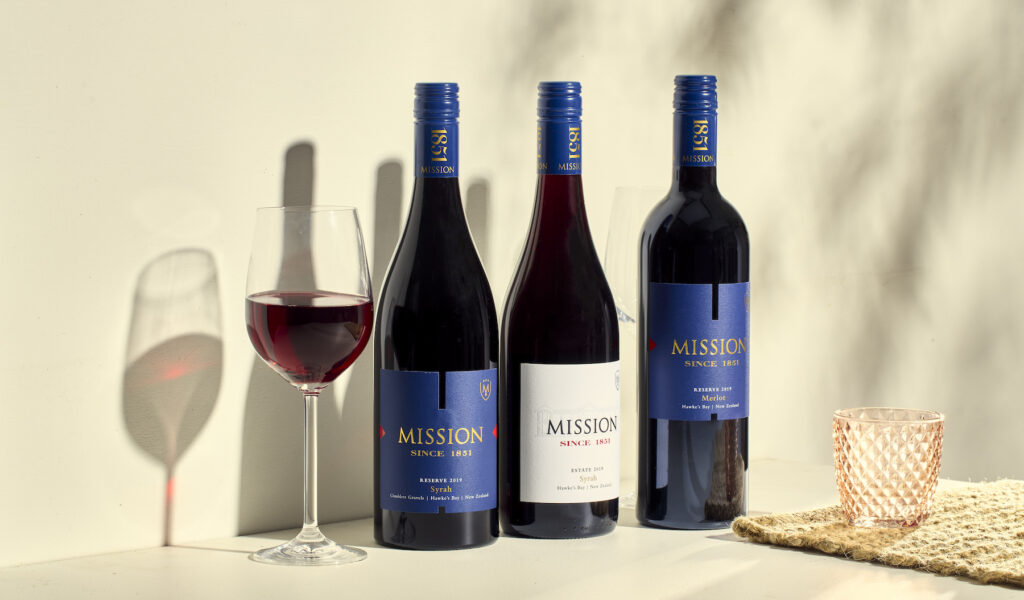
PM: The background of that wine is basically a blend of two vineyards. We’ve got a vineyard out here with the old Mendoza clones, from around 1995. They’ve got virus, quite badly, so we have to hang the fruit longer – about two weeks longer to get it ripe. But, at the end, it seems to have a depth, a dimension. And then the other vineyard, partly Gimblett Gravels, has this block with that riper spectrum and a bit more grunt and depth. It’s all hand picked and whole bunch pressed. This vineyard here we always get really high, citrussy acidity.
Even back in the 1990s I was reading papers about lees ageing – in France its common to use lees age for up to two years. So I started back then in ’91 experimenting with extensive lees ageing – in barrel for 18 months. We didn’t really pursue that too much, but in the past few years we have, because I think it helps with the ageability. We did a ’13 like that – in that style, and that’s aged really, really well.
WF: I don’t know the technical details, but I do find that lees ageing adds ‘personality’ to a wine. That’s hard to define and pick apart, but for me, it just adds something extra and gives more character to a wine.
PM: This is the Huchet Syrah. An interesting variety and it can be difficult in some years. If you get too much rain.. you’re really better off with a dry settled autumn. About 8 years ago, in our Mere Road vineyard, two thirds of our two acres of Syrah was converted to organics. Last year was a very good Syrah vintage, and this fruit is from a specific area. This is our real effort to make a top, iconic wine. We’ve just pulled it out of the barrel, so we’ll bottle it in a month or so.
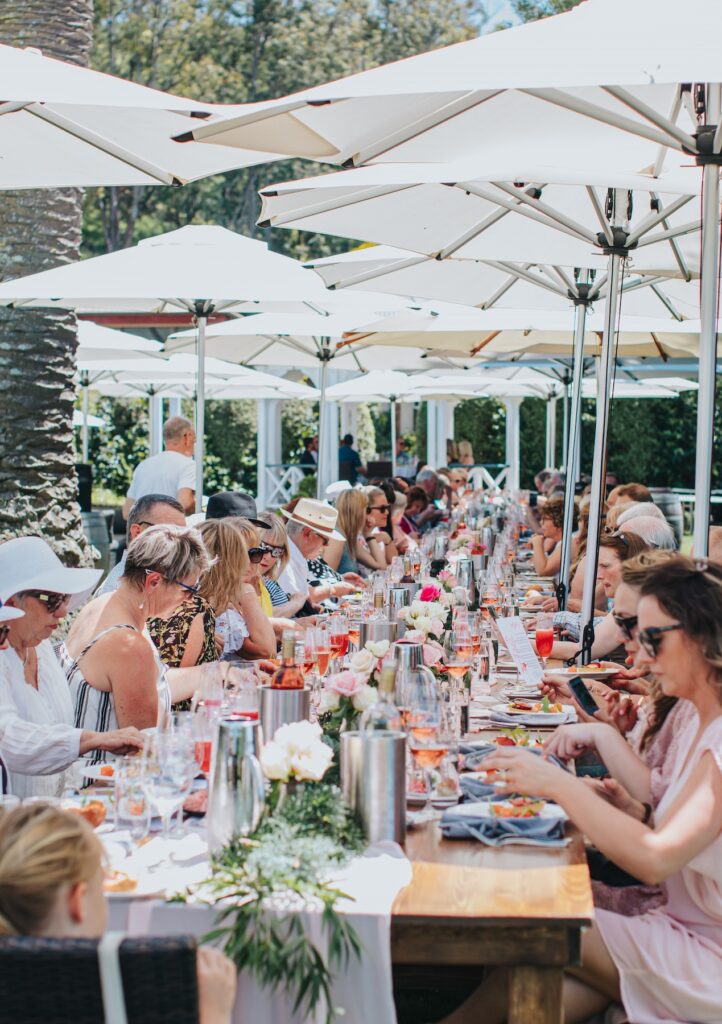
WF: Well, I thought the Chardonnay was floral – this is off the chart floral! Really aromatic isn’t it? I think the Syrah here is the one varietal that really expresses site – other than perhaps coastal Chardonnay from somewhere like Te Awanga. And I think it’s the best expression of Hawke’s Bay as a regional identity. You can say the Chardonnay here is really good – and I’d agree. And I love the Cabernet Franc from Hawke’s Bay. This one, I think because it’s ripe – it’s not too peppery. It’s a reasonably big wine – got good tannins. Treading a line between both red and blue fruits – blueberry, raspberry and cranberry. And a slight resinous note to it – cedar, sandalwood, but I’m not getting any of that cinnamon or green-ness from whole bunch – is there any?
PM: The block it’s from has a bit more silt over the gravels, and I think that helps the texture of this wine. No whole bunch, we aren’t really set up for that.
WF: This Huchet Syrah is really developing whilst we’re talking, as well. I’m getting chocolate, black tea and that greeny lightly roasted coffee bean note as well.
PM: We use a specific barrel for this too, that we’ve figured out that we really like. It’s a Taransaud 119 – pretty well their most expensive barrel. The only thing more expensive is one that’s about 1500 euros each. It’s a particular style and it gives a lot of wood tannin, so you’ve got to have the right wine but it seems to work really well with this vineyard. It’s just something you discover.
WF: It can be hard as a writer to be given something that you have to write about right now, without sounding like an idiot and trying to predict its future. You can only review it right now – I don’t know that it’s going to become this or that. So I quite often do the reviews of things like this with a little introduction and some context – then the review – and then some afterthoughts that might say “I think this deserves to be cellared for years before drinking, even though I’m drinking it now’.
And I used to do restaurant reviews, which people assume is the greatest job ever. And it is good, but it’s also kind of spoiling something that you really love – having to analyse and pick things apart. It’s sort of fun to review wines. But it could also end up spoiling something that you’re just supposed to enjoy – not dissect it constantly. And when I wrote restaurant reviews you’d be trying to see the best in the experience – I remember once not really liking the food, so I focussed on writing about the fabulous view from the venue!
I’ve had your ‘Antoine’ and ‘Huchet’ wines before but they haven’t always leapt out at me – at that level. Clearly against other estate-level wines they look great.
PM: In defence of our styles – we had one of our wines – a Jewelstone Cabernet-Merlot 09 put on a tasting in Hong Kong against half a dozen top French wines and half a dozen Gimblett Gravels in the line up. The tasting was done ‘double blind’ and our wine was third. I’ll defend it. Our wines do stack up.
For the Huchet Cabernet, we’ve got a really stony block in the Gimblett Gravels where we grow our Cabernet. It’s spent twelve months in 100% new oak, but then we’ve transferred into six 2-3 year old barrels, and we’ll give this another nine months. Just to give that oak time to integrate.
